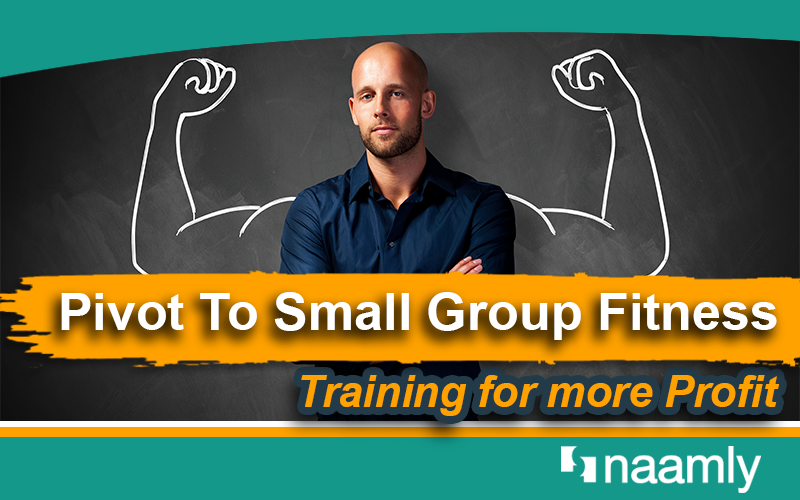Let’s do some quick math.
Just a little. It’ll be easy.
Would you rather get paid $100 an hour by one fitness client – or $50 an hour by four clients?
Yep: Easy-peasy. You’d pivot to small group fitness training (with four clients at a lower rate) to make the bigger payday.
Small group personal training has emerged in recent years as a leading trend in the country’s fitness industry. It’s easy to see why, with simple math examples like these bringing in more money to gym owners and trainers.

And it’s a genuine win-win, with more clients able to access private training at the more affordable rates. And they find strength in numbers, with helpful camaraderie and accountability that spurs them toward their goals.
So, let’s get into it. Should you pivot to small group fitness training?
Is $200 more than $100?
It gives gym owners and trainers a way to make more money while delivering better client experiences. At the same time, it boosts revenue and client satisfaction because they get heightened attention from a trainer and more social support.
See? Win-win!
Profitability Wins
With previously popular large-group classes, gyms and trainers offered lower prices to pack rooms full of sweaty, heaving clients. That was already showing signs of age when the pandemic came along and made that idea even less attractive to health-minded masses.
Small group personal training flips the idea on its head. You limit the sessions to about six participants. Each gets plenty of one-on-one coaching. And they pay more than they would’ve for a general gym membership or for large-group training, but a lot less than they would for individual personal training.
A gym member might balk at spending $100 an hour to have a trainer focusing on just him or her but be delighted to spend half as much for shared attention. Not every client needs or wants a trainer at his or her shoulder every moment; a little less coaching can be just as effective.

That’s a great reason to pivot to small group fitness training for your business.
Gym owner and fitbiz coach Vince Gabriele found it such a “no brainer” that he wrote a book about it, “The Ultimate Guide To Small Group Personal Training: How To Make Millions with Small Group Training,” last year.
“Sometimes things take time for people to adapt to changing ways,” Vince told the Optimal Aging podcast. “For so many years we just thought that one-on-one is the only way to do personal training. Now I think that more people are starting to look at this model and build businesses around it.”
He says it should be a comparable experience for the consumer if your gym makes the pivot to small group fitness training.
“What does someone get in a one-on-one session? They get guidance from a coach, they get a really good close communication, they get individualization, they get progression,” he says.
“They get all these things from a one-on-one personal training session and the goal is that they get everything that they would get in that one-on-one session, but they do it in a small group environment with a few other people at a fraction of the price” at a gym that can pivot to small group fitness training.
Building a Franchise
Rick Mayo, CEO and founder of the Alloy Personal Training, turned his Atlanta-area studio systems into a national chain that has sold almost 300 franchise locations, with more coming.
He addressed a common question about making the pivot to small group fitness training on the Alloy podcast.
Gym owners often ask if they should have individualized client programs in the small group personal training.
Alloy says no – it would be impossible for the coach to deliver a great customer experience that way.
Alloy studios run the same workout throughout the day but with variations to account for injuries, preferences and other factors.

Alloy says there’s an art to coaching different levels of fitness in the same group session. It means walking a tightrope between science, programming and entertainment to deliver an exceptional client experience.
Rick says small group personal training is on the scale between class-based fitness concepts on one end, and one-on-one training on the other end, which isn’t as scalable, profitable, and affordable.
“We sit in the sweet spot in between,” Rick says. “We are attacking the same customer avatar as the one-on-one customer training gym; we’re just giving them a better value.
“What does that person in front of me need today? Where are they mentally, are they in a good, bad mood… There’s a lot of factors that enter in.”
And after you have made the pivot to small group fitness training, remember this: Each client should be treated like he or she is the only client in the gym that day. Use their names, explain exercises, thank them for coming – all parts of a positive, consistent customer experience for each individual.
Friendships Blossom
Here’s a powerful story of friendship at a gym that made the pivot to small group fitness training.
In Houston a few years ago, when Glenna Brown’s husband became ill, she found that regular exercise at Evolution Fitness and Wellness helped her deal with the stress and remain strong enough to be a good caregiver.
When he died, Glenna found more: a loving support group and a new friend who was going through a similar experience.
That was Shirley Nunez, whose husband also had died. The two became fast buddies, working out together, socializing, and even traveling.

“I saw Glenna working out and said, ‘I want to be like her,’” says Shirley. “She’s been my lifesaver and just everything.”
Their story proves the power of working out with other people at a studio or gym. Social support, accountability and friendliness are crucial for older people trying to get in shape or stay in shape.
“The sense of community is as vital as the exercise itself,” says co-owner Jackie Bachmeier.
Conclusion
So, if you want to make more money, involve more clients in personal training, and help nurture a friendly environment, it’s a very simple formula to consider adding into your business.
If you want to make the pivot to small group fitness training, there are many solid reasons to do so.
See? Math isn’t so bad! And if you want to learn about keeping members longer, be sure to get our free “9 Secrets to Increase Retention.”


